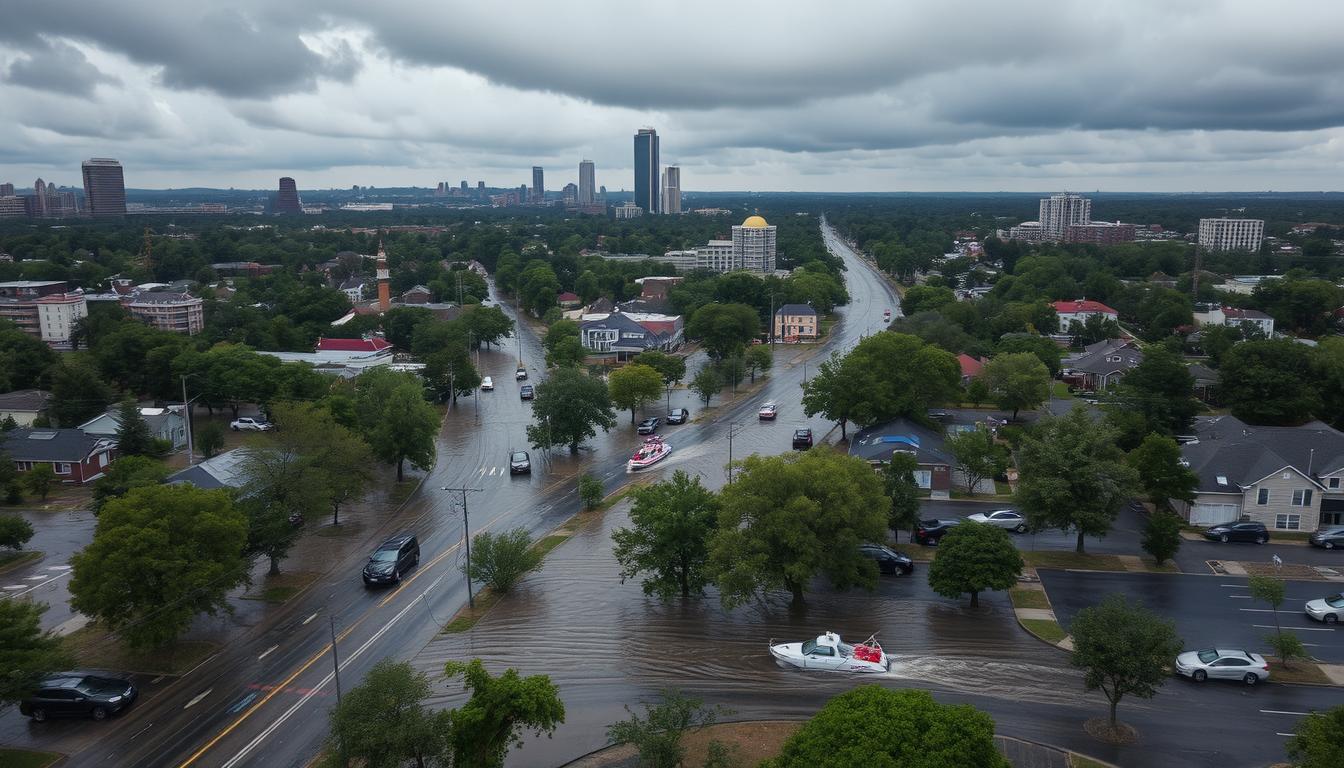Can Atlanta’s flood plans handle Hurricane Helene’s challenge? The city faces its first flash flood emergency. This has raised big questions for everyone. Lives have been lost, power is out, and emergency teams are working hard.
This disaster shows we need better ways to deal with climate change. It affects communities in big ways.
Hurricane Helene’s flooding has hit the southeastern U.S. hard. Six people have died in Georgia, North Carolina, and Florida. Over 3 million are without power.
Rescue teams are trying to reach those trapped by floods. The damage is still being assessed. This highlights the need for better disaster plans due to climate change.
Current Situation
Tropical Storm Helene is moving through Georgia, causing damage. It was about 40 miles east of Macon and 100 miles southeast of Atlanta early Friday. The storm is weakening but has already caused a lot of damage.
This damage shows how important storm water management and infrastructure resilience are. They help protect us from storms like Helene.
Helene has affected many states, including Florida’s west coast. There, winds were strong, and water covered roads. The North Carolina mountains also got a lot of rain, which could lead to flooding.
According to Georgia Public Broadcasting, over 2.1 million homes and businesses lost power. In Georgia, more than 1.1 million people are without electricity. The storm also caused problems with flights, with 62 canceled and over 100 delayed.
| County | Storm-related Deaths |
|---|---|
| Wheeler | 2 |
| Laurens | 2 |
| Jeff Davis | 1 |
| Colquitt | 1 |
At least five people have died because of Helene. The deaths were in Wheeler, Laurens, Jeff Davis, and Colquitt counties. Governor Brian Kemp has sent 1,000 more National Guard troops to help. He also asked people to stay off the roads.
With warnings for tropical storms and flash floods, the situation is serious. The Atlanta area and parts of North Georgia could get 10 inches of rain. This highlights the need for good storm water management and infrastructure resilience.
Emergency Response and Water Rescues
As Hurricane Helene hit the southeastern United States, emergency teams worked hard to save lives. They were ready, knowing the storm could cause huge damage. Governors from Florida to Virginia declared emergencies, showing how serious the situation was.
People in low-lying areas were told to leave quickly. Over 100 water rescue calls were made in Florida and Georgia. In Pasco County, Florida, more than 65 people were pulled to safety from rising waters.
| Location | Number of People Rescued |
|---|---|
| Pasco County, Florida | 65+ |
| Atlanta, Georgia | 25 |
| US-19 Corridor, Florida | 65 |
The Atlanta Fire Rescue Department rescued 25 people from floods. Their bravery shows how crucial emergency planning is. It’s clear that quick action and water rescues are key to dealing with hurricanes.
Emergency workers and the community’s cooperation are inspiring. They show the strength and unity we can find in hard times. As we deal with Hurricane Helene’s aftermath, we must keep planning for the future.
Rising Death Toll and Injuries
Hurricane Helene is causing chaos in the southeastern United States. At least six people have died. This is a harsh reminder of the need for environmental risk mitigation.
In Florida, where Helene hit as a Category 4 hurricane, one person died from a falling sign. The storm’s size and strength have caused record flooding. This has affected Florida, Alabama, and parts of the Carolinas.
Early warning systems and evacuation plans have helped save lives. In south Georgia, two people died in a possible tornado. In Charlotte, North Carolina, a tree fell on a house, killing one and injuring another.
Georgia’s Governor Brian Kemp has expressed his condolences. He urged people to stay alert as Helene continues. The state is committed to improving its environmental risk mitigation efforts.
| State | Fatalities | Injuries |
|---|---|---|
| Florida | 1 | 0 |
| Georgia | 2 | 0 |
| North Carolina | 1 | 1 |
Florida’s Governor Ron DeSantis fears more deaths and damage as Helene moves. Improving infrastructure and flood control is key to reducing hurricane damage.
The affected states are working to help those affected. Investing in environmental risk mitigation is crucial. By learning from Hurricane Helene, we can better protect our communities from severe weather.
Impact on Infrastructure and Daily Life
Hurricane Helene has hit the southeastern United States hard. Over 3 million people are without power, with 1.1 million in Georgia. Urban planning teams are working fast to fix the damage and get services back.
Power outages have closed schools, universities, and businesses. Georgia Power has sent 10,000 linemen to fix the problem. This shows how important good planning is in emergencies.
The storm also messed up air travel. Over 100 flights were delayed, and 62 were canceled in Atlanta. Airports in Tampa, Tallahassee, and St. Petersburg also stopped operations.
| State | Customers Without Power |
|---|---|
| Florida | 1,000,000 |
| Georgia | 900,000 |
| South Carolina | 900,000 |
| North Carolina | 300,000 |
As the storm moves, experts predict more power outages and flooding. The damage to infrastructure and daily life will be big. It will take a team effort to help communities recover quickly.
Hurricane Helene could hurt Georgia’s cotton and pecan crops during harvest. The storm’s economic effects will last long after it’s gone. Urban planning that focuses on resilience and adaptability will help communities recover and grow stronger.
Community Support and Resources
After Hurricane Helene, communities are coming together to help each other. Local groups, organizations, and volunteers are working hard. They make sure people have shelter, food, water, and medical care.
Emergency shelters are open for those who had to leave their homes. These places offer a safe place to stay and basic needs. Georgia even lets evacuees and their pets, including horses, stay in parks.
Volunteers and community groups are key in the relief efforts. They collect and give out food, water, blankets, and hygiene items. They also help with cleanup and recovery, helping families start over.
The need for emergency planning is clear after Hurricane Helene. Local authorities are working with state and federal agencies. Together, they make sure help reaches where it’s needed most. Communities are showing their strength and resilience.
| State | Power Outages |
|---|---|
| Georgia | 683,000 |
| North Carolina | 698,964 |
| South Carolina | 19,870 |
| Upstate South Carolina | 220,414 |
| Western North Carolina | 117,962 |
As recovery starts, knowing what resources are available is key. Local websites and social media have updates on shelters and supplies. By staying informed, communities can face challenges together and come out stronger.
Historical Context and Future Preparedness
Hurricane Helene is a historic storm, the first Category 4 to hit Florida’s Big Bend Region since 1859. It could bring the worst storm to Atlanta in 35 years, showing the dangers of climate change. As storms get stronger, it’s vital for communities to get ready for floods and be resilient.
Improving infrastructure is crucial for cities to face climate change. This means better drainage, stronger bridges, and flood barriers. Also, having good emergency plans is key for safety during storms. Civil society groups help push for these steps and support getting communities ready.
Teaching people how to stay safe in bad weather is also important. This includes knowing about hurricane and flood risks, emergency kits, and evacuation routes. By learning from storms like Hurricane Helene, we can make our communities stronger against climate change. With planning, investing in infrastructure, and education, we can reduce disaster impacts and keep everyone safe.












2 thoughts on “Atlanta Faces First Flash Flood Emergency as Helene Sparks Water Rescues and Rising Death Toll”